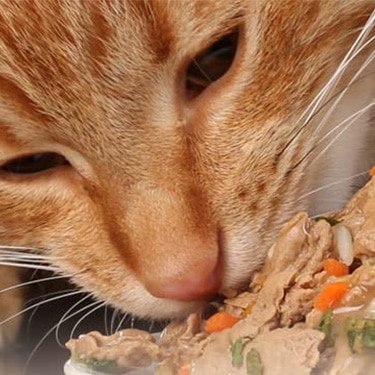

No one wants to experience finding blood in their cat's vomit. What does it mean? Where is it coming from? What's the next step? In most cases, a cat vomiting blood is a medical emergency that requires prompt veterinary intervention. In this article, you'll learn what bloody vomit looks like in cats, conditions associated with a cat throwing up blood and what to expect based on your vet's diagnosis.
What Does Blood in Vomit Look Like?
This may seem like a question with an obvious answer. But bloody vomit, otherwise known as hematemesis, isn't always as straightforward as it sounds. The most obvious sign is seeing streaks of fresh, bright red blood, but bloody vomit can also contain blood clots or digested blood, which can look like coffee grounds. If you suspect your pet may have blood in their vomit, reach out to your veterinarian immediately.
Depending on the cause, cats who are vomiting blood may lose their appetite or show signs of pain or discomfort. They may also hide. If a cat is vomiting blood due to a bleeding disorder, they may have signs of bleeding elsewhere, such as bloody or very dark stool or unexplained bruising.

What Other Signs Can Accompany a Cat Throwing Up Blood?
Any cat throwing up blood needs veterinary attention as soon as possible. The cause may not be life-threatening, but your vet is the best source of information you have. If your regular vet is closed, take your cat to an emergency clinic.
In some cases, your cat may show other signs in addition to vomiting blood, such as:
Failing to eat or inability to keep anything down
Passing bloody stool
Acting weak or non-responsive
Seizing
Having difficulty breathing
Showing signs of pain (e.g., hiding or vocalizing)
Contact Your Vet Right Away
If you see any of these signs or feel unsure in any way, call your vet for advice as soon as you can. You know your cat best, and if you think something's wrong, it's better to be safe than sorry.
What Causes Blood in Vomit?
Several conditions may be associated with a cat throwing up blood. These can include:
Primary gastrointestinal (GI) problems (e.g., inflammatory bowel disease, intestinal parasites, hemorrhagic gastroenteritis, stomach or esophageal ulcers, GI tract trauma, etc.)
Foreign body stuck in the esophagus, stomach or intestines
Metabolic diseases, such as kidney or liver disease, Addison's disease or pancreatitis
Poisoning or toxicity from unauthorized medications (e.g., nonsteroidal anti-inflammatories), heavy metals, toxic plants, rat poison or pesticides
Neurological disease from head trauma
Septic shock from severe bloodstream infections
Heat stroke or severe burns
Major surgery
High blood pressure
Blood clotting disorders
Snake bite
One of the most important differentiations is whether your cat is vomiting blood from the GI tract, spitting out blood from the mouth or coughing up blood from the respiratory tract. Your vet will examine and run tests on your cat to determine where the blood is coming from.
Cat Vomiting Blood: Diagnosis and Treatment
At your appointment, the veterinary care staff will assess your cat's vitals and take an oral history from you. The vet will conduct a physical examination and recommend testing and/or treatment based upon their findings.
Testing
Your vet will likely recommend the following tests:
Blood tests to assess blood cell health and internal organ function
Urinalysis to assess kidney function and lower urinary tract health
Imaging studies, such as abdominal ultrasound and radiographs (X-rays), to look for any GI disease or foreign bodies in the GI tract
Blood pressure monitoring
Additional testing may include:
Fecal flotation test to check for parasites
Coagulation profile to check for blood clotting
Bile acid testing to check for liver disease
ACTH (adrenal function test) to check for Addison's disease
Endoscopy to evaluate the esophagus and stomach, +/- biopsy

Treatment
Treatment depends on the cause. Your vet may administer medications to reduce nausea and protect the GI tract lining, such as antacids, sucralfate, maropitant or antibiotics if indicated. They may also recommend a highly digestible food or a source of prebiotics or probiotics to support the gut microbiome and promote GI health.
Beyond that, treatment is disease-specific. For example:
Vitamin K for a clotting disorder (and a blood transfusion if needed)
Deworming for intestinal parasites
An oncologist referral for suspected cancer
Surgery for a GI tract obstruction
Paying Attention Is Caring
While this can be a worrisome subject, the most important takeaway is to pay attention to your cat's behavior. If you're concerned about your cat's health, get them to a vet as soon as possible. They can assess your cat and determine the best course of action to help them feel better.
By catching problems early, vets have a better chance of resolving the situation, and your cat has a better chance of making a smooth recovery. As a pet parent, your job is to take your cat to the vet for their annual checkup, seek treatment when they're unwell and give them lots of attention, care and love.





















